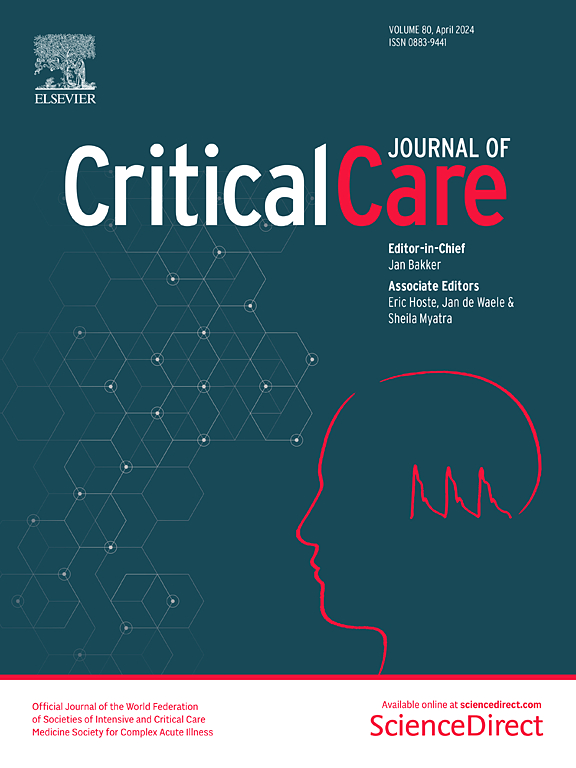An international observational study validating gene-expression sepsis immune subgroups
IF 8.8
1区 医学
Q1 CRITICAL CARE MEDICINE
引用次数: 0
Abstract
Sepsis gene-expression sub-phenotypes with prognostic and theranostic potential have been discovered. These have been identified retrospectively and have not been translated to methods that could be deployed at the bedside. We aimed to identify subgroups of septic patients at high-risk of poor outcome, using a rapid, multiplex RNA-based test. Adults with sepsis, in the intensive care unit (ICU) were recruited from 17 sites in the United Kingdom, Sweden and France. Blood was collected at days 2–5 (S1), 6–8 (S2) and 13–15 (S3) after ICU admission and analyzed centrally. Patients were assigned into ‘high’ and ‘low’ risk groups using two models previously developed for the Immune-Profiling Panel prototype on the bioMérieux FilmArray® system. 357 patients were recruited (March 2021–November 2022). 69% were male with a median age of 67 years, APACHE II score of 21 and a 30% 90-day mortality rate. The proportions of high-risk patients decreased over the three sampling times (model 1: 53%, 40%, 15% and model 2: 81%, 74%, 37%). In model 1, 90-day mortality was higher in a high-risk group at each time (S1: 35% vs 24%, p = 0.04; S2: 43% vs 20%, p < 0.001; S3: 52% vs 24%, p = 0.007). In model 2, mortality was only significantly different at the second sampling time (S1: 30% vs 27%, p = 0.77; S2: 34% vs 14%, p = 0.002; S3: 35% vs 23%, p = 0.13). Gene-expression diagnostics can identify patients with sepsis at high-risk of poor outcomes and could be used to identify patients for precision medicine trials. ISRCTN11364482 Registered 24th September 2020.一项验证败血症免疫亚群基因表达的国际观察性研究
已发现具有预后和治疗潜力的脓毒症基因表达亚表型。这些都是回顾性确定的,尚未转化为可在床边部署的方法。我们的目的是使用一种快速的、基于多重rna的检测方法来确定脓毒症患者预后不良的高危亚组。重症监护病房(ICU)的成人脓毒症患者从英国、瑞典和法国的17个地点招募。于ICU入院后第2 ~ 5天(S1)、第6 ~ 8天(S2)、第13 ~ 15天(S3)采血集中分析。患者被划分为“高”和“低”风险组,使用的是先前在biomacrieux FilmArray®系统上为免疫分析小组原型开发的两个模型。357名患者被招募(2021年3月- 2022年11月)。69%为男性,中位年龄67岁,APACHE II评分为21分,90天死亡率为30%。三次采样后,高危患者的比例下降(模型1:53%、40%、15%,模型2:81%、74%、37%)。在模型1中,高风险组每次90天死亡率均较高(S1: 35% vs 24%, p = 0.04;S2: 43% vs 20%, p < 0.001;S3: 52% vs 24%, p = 0.007)。在模型2中,死亡率仅在第二次采样时存在显著差异(S1: 30% vs 27%, p = 0.77;S2: 34% vs 14%, p = 0.002;S3: 35% vs 23%, p = 0.13)。基因表达诊断可以识别预后不良的高危败血症患者,并可用于识别精准医学试验的患者。ISRCTN11364482注册于2020年9月24日。
本文章由计算机程序翻译,如有差异,请以英文原文为准。
求助全文
约1分钟内获得全文
求助全文
来源期刊

Critical Care
医学-危重病医学
CiteScore
20.60
自引率
3.30%
发文量
348
审稿时长
1.5 months
期刊介绍:
Critical Care is an esteemed international medical journal that undergoes a rigorous peer-review process to maintain its high quality standards. Its primary objective is to enhance the healthcare services offered to critically ill patients. To achieve this, the journal focuses on gathering, exchanging, disseminating, and endorsing evidence-based information that is highly relevant to intensivists. By doing so, Critical Care seeks to provide a thorough and inclusive examination of the intensive care field.
 求助内容:
求助内容: 应助结果提醒方式:
应助结果提醒方式:


